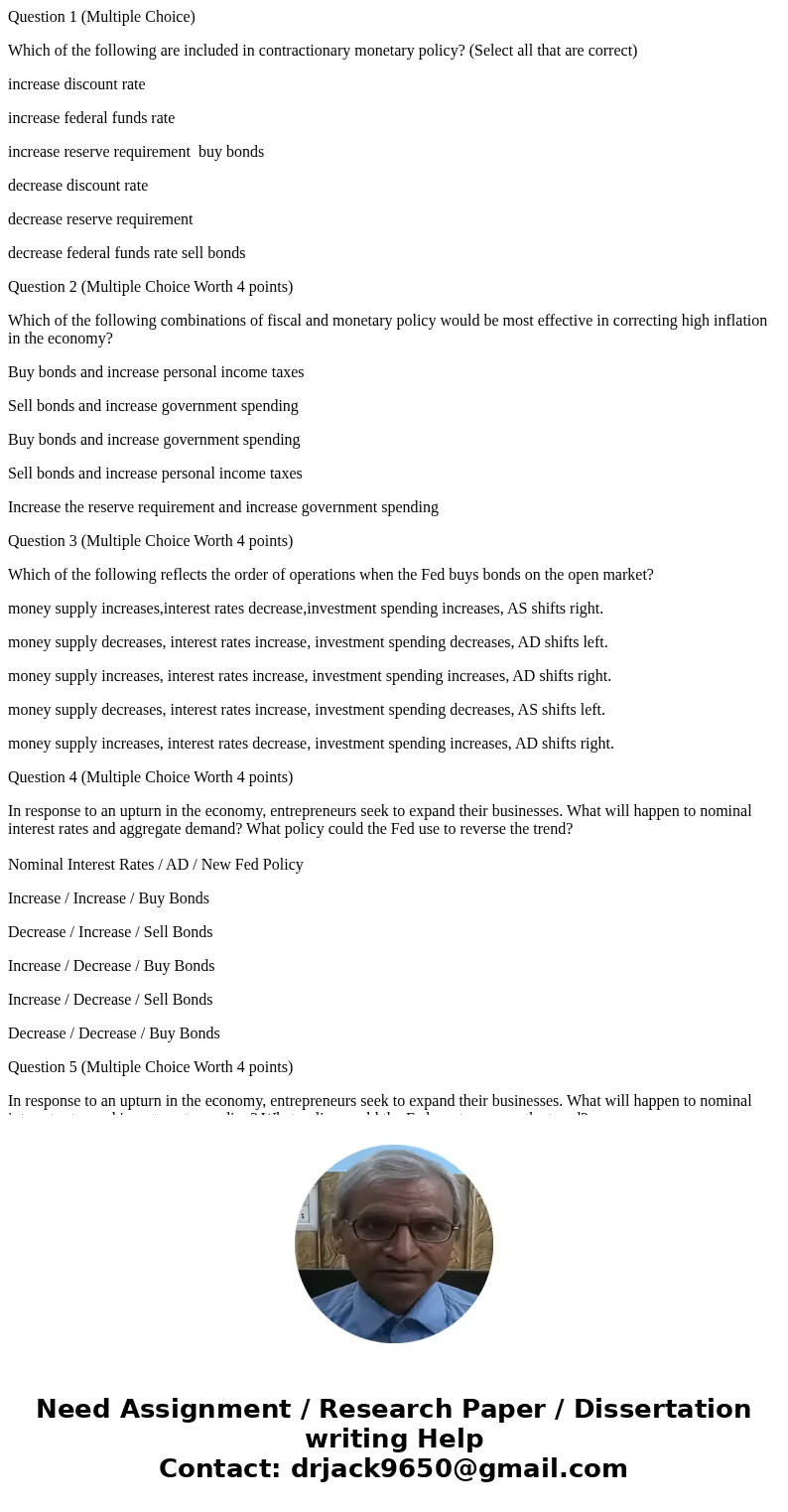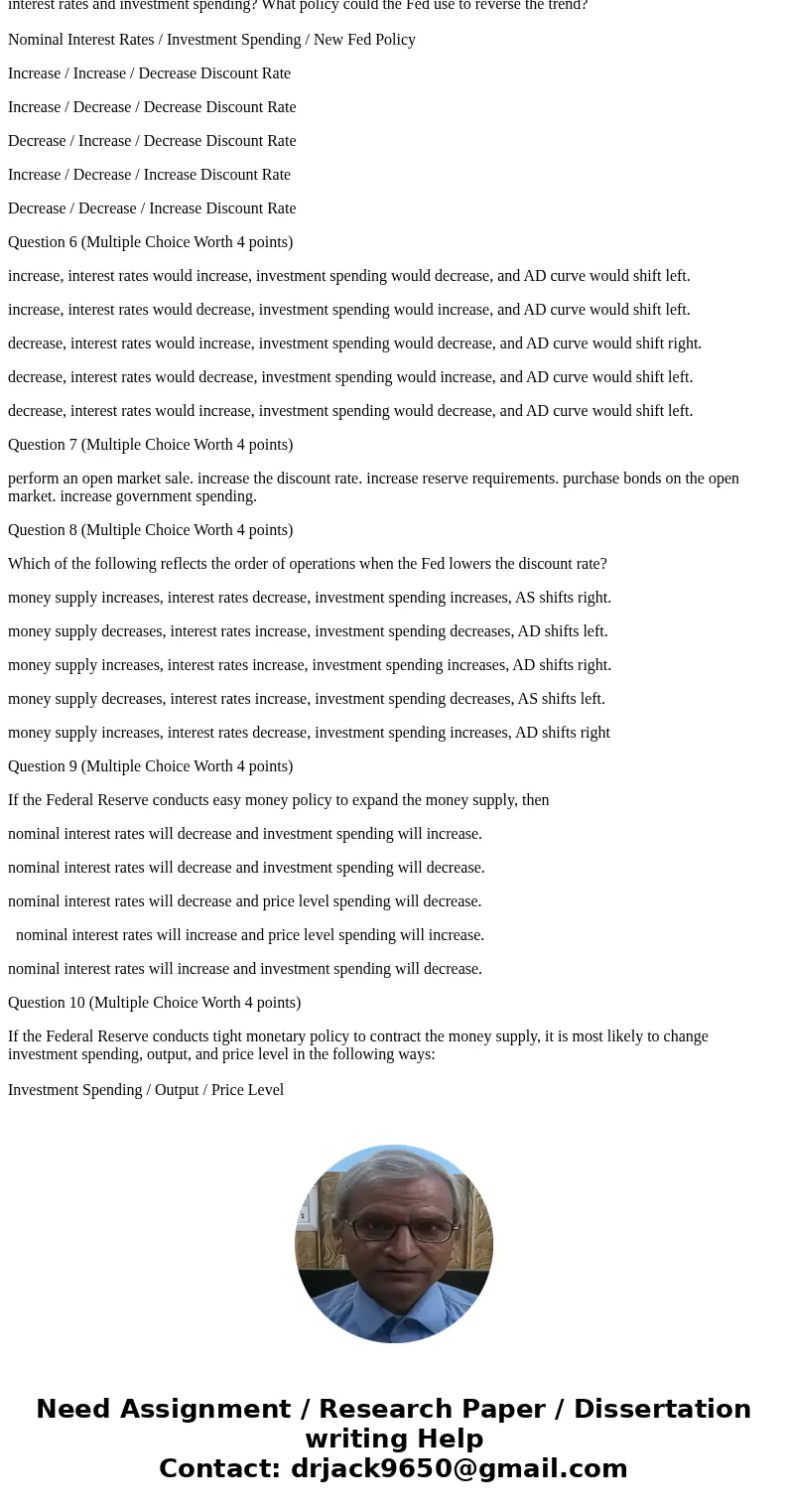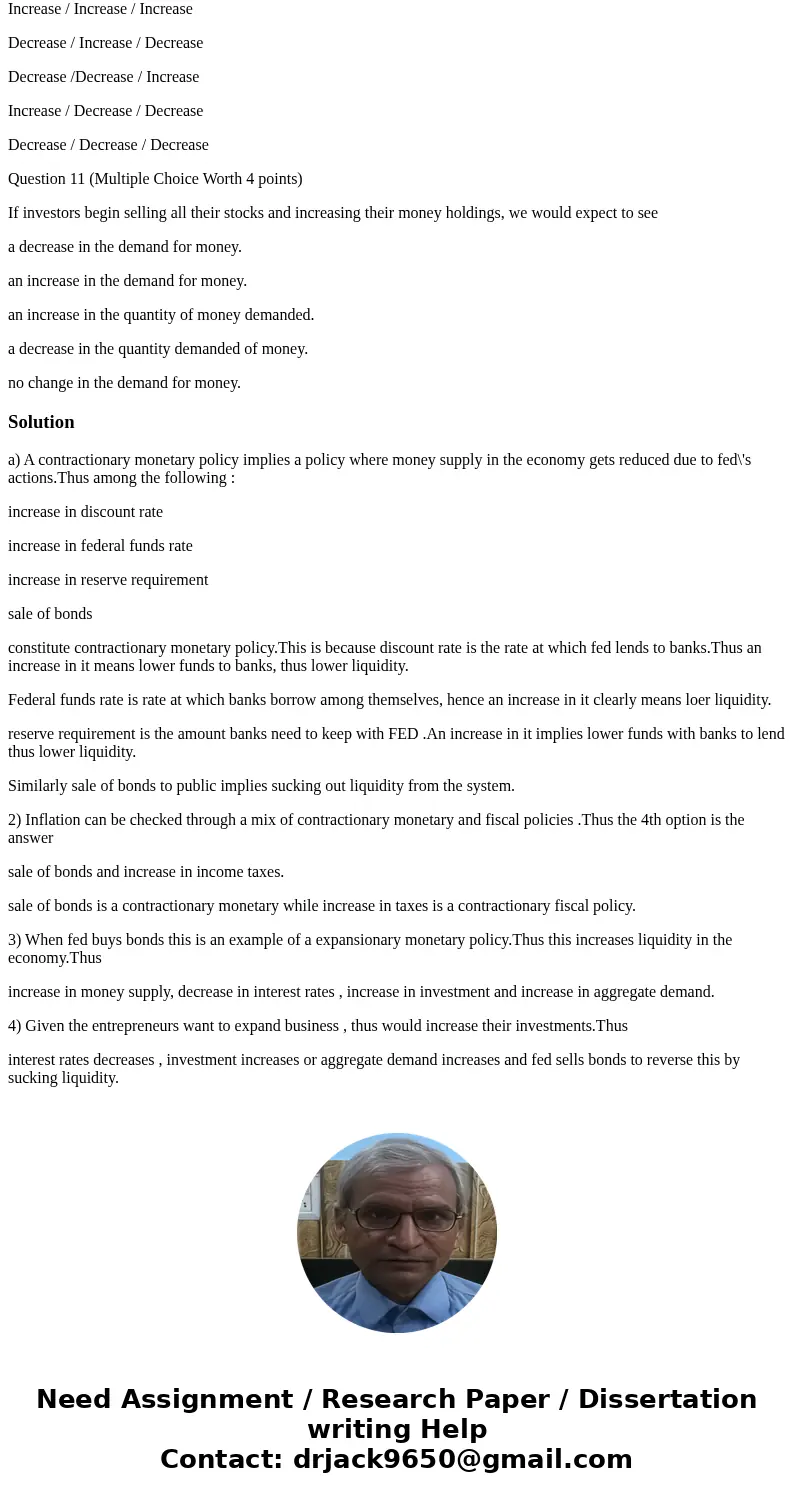Question 1 Multiple Choice Which of the following are includ
Question 1 (Multiple Choice)
Which of the following are included in contractionary monetary policy? (Select all that are correct)
increase discount rate
increase federal funds rate
increase reserve requirement buy bonds
decrease discount rate
decrease reserve requirement
decrease federal funds rate sell bonds
Question 2 (Multiple Choice Worth 4 points)
Which of the following combinations of fiscal and monetary policy would be most effective in correcting high inflation in the economy?
Buy bonds and increase personal income taxes
Sell bonds and increase government spending
Buy bonds and increase government spending
Sell bonds and increase personal income taxes
Increase the reserve requirement and increase government spending
Question 3 (Multiple Choice Worth 4 points)
Which of the following reflects the order of operations when the Fed buys bonds on the open market?
money supply increases,interest rates decrease,investment spending increases, AS shifts right.
money supply decreases, interest rates increase, investment spending decreases, AD shifts left.
money supply increases, interest rates increase, investment spending increases, AD shifts right.
money supply decreases, interest rates increase, investment spending decreases, AS shifts left.
money supply increases, interest rates decrease, investment spending increases, AD shifts right.
Question 4 (Multiple Choice Worth 4 points)
In response to an upturn in the economy, entrepreneurs seek to expand their businesses. What will happen to nominal interest rates and aggregate demand? What policy could the Fed use to reverse the trend?
Nominal Interest Rates / AD / New Fed Policy
Increase / Increase / Buy Bonds
Decrease / Increase / Sell Bonds
Increase / Decrease / Buy Bonds
Increase / Decrease / Sell Bonds
Decrease / Decrease / Buy Bonds
Question 5 (Multiple Choice Worth 4 points)
In response to an upturn in the economy, entrepreneurs seek to expand their businesses. What will happen to nominal interest rates and investment spending? What policy could the Fed use to reverse the trend?
Nominal Interest Rates / Investment Spending / New Fed Policy
Increase / Increase / Decrease Discount Rate
Increase / Decrease / Decrease Discount Rate
Decrease / Increase / Decrease Discount Rate
Increase / Decrease / Increase Discount Rate
Decrease / Decrease / Increase Discount Rate
Question 6 (Multiple Choice Worth 4 points)
increase, interest rates would increase, investment spending would decrease, and AD curve would shift left.
increase, interest rates would decrease, investment spending would increase, and AD curve would shift left.
decrease, interest rates would increase, investment spending would decrease, and AD curve would shift right.
decrease, interest rates would decrease, investment spending would increase, and AD curve would shift left.
decrease, interest rates would increase, investment spending would decrease, and AD curve would shift left.
Question 7 (Multiple Choice Worth 4 points)
perform an open market sale. increase the discount rate. increase reserve requirements. purchase bonds on the open market. increase government spending.
Question 8 (Multiple Choice Worth 4 points)
Which of the following reflects the order of operations when the Fed lowers the discount rate?
money supply increases, interest rates decrease, investment spending increases, AS shifts right.
money supply decreases, interest rates increase, investment spending decreases, AD shifts left.
money supply increases, interest rates increase, investment spending increases, AD shifts right.
money supply decreases, interest rates increase, investment spending decreases, AS shifts left.
money supply increases, interest rates decrease, investment spending increases, AD shifts right
Question 9 (Multiple Choice Worth 4 points)
If the Federal Reserve conducts easy money policy to expand the money supply, then
nominal interest rates will decrease and investment spending will increase.
nominal interest rates will decrease and investment spending will decrease.
nominal interest rates will decrease and price level spending will decrease.
nominal interest rates will increase and price level spending will increase.
nominal interest rates will increase and investment spending will decrease.
Question 10 (Multiple Choice Worth 4 points)
If the Federal Reserve conducts tight monetary policy to contract the money supply, it is most likely to change investment spending, output, and price level in the following ways:
Investment Spending / Output / Price Level
Increase / Increase / Increase
Decrease / Increase / Decrease
Decrease /Decrease / Increase
Increase / Decrease / Decrease
Decrease / Decrease / Decrease
Question 11 (Multiple Choice Worth 4 points)
If investors begin selling all their stocks and increasing their money holdings, we would expect to see
a decrease in the demand for money.
an increase in the demand for money.
an increase in the quantity of money demanded.
a decrease in the quantity demanded of money.
no change in the demand for money.
Solution
a) A contractionary monetary policy implies a policy where money supply in the economy gets reduced due to fed\'s actions.Thus among the following :
increase in discount rate
increase in federal funds rate
increase in reserve requirement
sale of bonds
constitute contractionary monetary policy.This is because discount rate is the rate at which fed lends to banks.Thus an increase in it means lower funds to banks, thus lower liquidity.
Federal funds rate is rate at which banks borrow among themselves, hence an increase in it clearly means loer liquidity.
reserve requirement is the amount banks need to keep with FED .An increase in it implies lower funds with banks to lend thus lower liquidity.
Similarly sale of bonds to public implies sucking out liquidity from the system.
2) Inflation can be checked through a mix of contractionary monetary and fiscal policies .Thus the 4th option is the answer
sale of bonds and increase in income taxes.
sale of bonds is a contractionary monetary while increase in taxes is a contractionary fiscal policy.
3) When fed buys bonds this is an example of a expansionary monetary policy.Thus this increases liquidity in the economy.Thus
increase in money supply, decrease in interest rates , increase in investment and increase in aggregate demand.
4) Given the entrepreneurs want to expand business , thus would increase their investments.Thus
interest rates decreases , investment increases or aggregate demand increases and fed sells bonds to reverse this by sucking liquidity.



 Homework Sourse
Homework Sourse